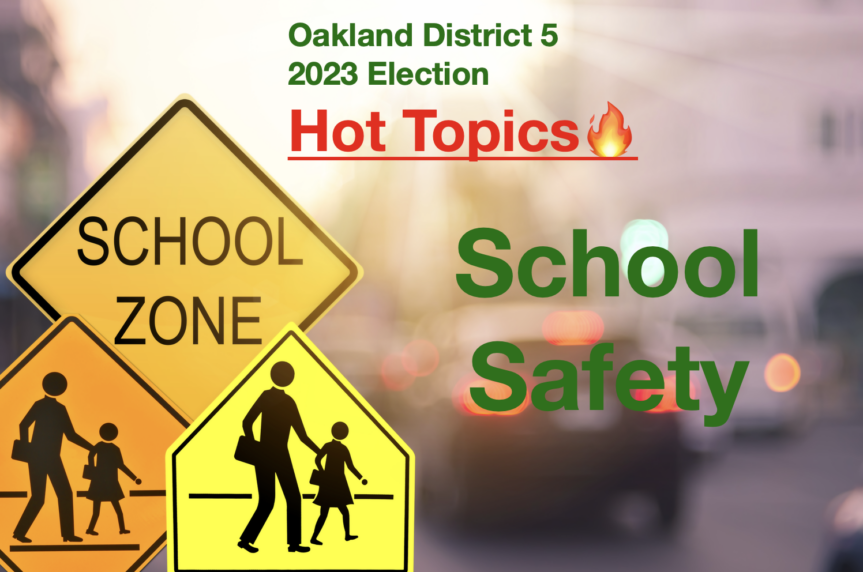There is one election in Oakland this year, for the District 5 school board. With a divided board, the person elected will have the opportunity to cast a deciding vote. With so much at stake, we wanted to hear directly from the candidates so voters and the public can better understand their views and plans for their time in office. Students will be those most affected by the decisions the board makes, so we collected student questions from the Oakland Youth Commission to ask candidates Sasha Ritzie-Hernandez and Jorge Lerma. This question is about school safety. Look out for future posts on graduation rates, charter schools, the school-to-prison pipeline, school closures and restorative justice.
Here is a link to the full interview with Ritzie-Hernandez.
Here is a link to the full interview with Lerma.
School Safety is a major concern for everyone in Oakland, especially with school shootings in the last year on campuses. What ideas do you have to improve school safety?
Sasha Ritzie-Hernandez
There are a couple of ideas that I have brought forward. One of them that I’m really, really passionate about is that every school has a safety plan. So ensuring that our safety plans are not only known by the the school community, but really working to disseminate information to the community, because the last thing we need when there’s a crisis, or there’s an emergency, is for our families to not know what to expect or who to call. So we want to ensure that all of our established emergency plans are also informed to our families, that our families know what to expect. In addition to that, one of the things that’s come up because I spend, at least once or twice a week, I really tried to spend as much time at the school site. I’ve had multiple conversations with staff, and one thing that’s come to light is that in the beginning of the school year, our teachers received a training and some of the the teachers shared with me that unfortunately, the training was not trauma informed, and he wasn’t culturally competent, which can be a challenge, because we want to ensure that if we have safety trainings, or anything in relationship to the potential of a crisis or an emergency, we want to be as sensitive as possible. So one of the things that I will be very committed to in terms of safety is also ensuring that wherever curriculum is available to our community, also is piloted by the community, that is reviewed by the community to ensure that we take in consideration our demographic, that we take into consideration our diversity, and that we don’t forget that what we’re trying to do is to inform the community to prevent harm. And so sometimes when we’re not eloquent with our words, or when we’re not really intentional about the trainings, it can cause more harm than you can benefit the community. Regardless of what happens on November 7, my commitment will be safety. I am already thinking and planning about what these moments leading up to the election can support. Me getting a better sense of where the community is, as far as solutions for safety. Now, the other thing that is at the table, and if elected I will be pushing for is the full implementation of the George Floyd resolution. Again, I’m not interested in recreating prisons in our schools. That is something that I don’t want to do. That further pushes our students through the school to prison pipeline by recreating those systems within our school. I’m not interested in bringing the police back or not interested in recreating those systems in our school sites. But I’m also interested in hearing from the community and implementing more restorative justice, which I hear from the students is super important mental health support. One of the conversations that I’ve been having is we need mental health services for everyone, and some of our teachers have also experienced some really challenging things. Making sure that our entire community feels like they will be supported and that the services are available to them. So those are some of the things that I’m thinking about in terms of safety.
Jorge Lerma
Yeah, great question. And it’s the right question. School Safety, let me say this first, it’s not just about the school, it’s connected to what’s going on in Oakland, and our community and what’s going on in every neighborhood. It has to do as much with equity as it does with disparity. Everybody thinks that creating safer schools, in the old days and the old way of thinking, meant security, police, guys or people walking around and stopping fights. No, we have a different notion of school safety. So it’s not just about the school. It must involve the city council, the mayor, and leaders from the county and the state. But there are things that we can do at the school site. One, the first step, is to set expectations. There must be an ongoing discussion about safety and code of conduct at every school every day in every classroom. It must be connected to the classroom curriculum. It’s not a separate thing, or something that you talk about when there’s a problem. Safety and wellness are discussions that should be a topic in itself. Review of the previous day or review of a situation that came up in the classroom. Dialogue is the first way to remediate a problem. And identify methods and techniques that people can use in the classroom, at the school site, whether it be debates, discussion circles, the spoken word. These feelings and these topics must have a place in the school curriculum. So yes, school safety is a complicated issue. But there are things that we can do both in the school and with the community.

